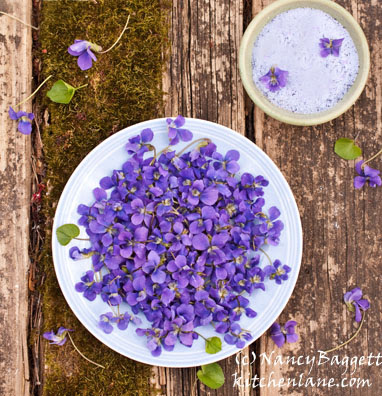
Spring has sprung! The garden and woods where I live are full of seasonal ephemerals, especially my favorites, the gloriously colorful and completely edible wild violets. To capture and hold their beauty beyond their short season, I harvest blooms from the purple carpets along the walking path behind my house and turn them into breathtaking garnishing sugar for vanilla-frosted cupcakes and cookies. I also grind the petals with granulated sugar to create a pretty purple decorating sugar that is completely dye-free.
 Depending on the particular shade of the violets, the sugar will have a lovely eye-catching purple or lavender color that can greatly enhance all kinds of baked goods and create a gorgeous pink lemonade, yet completely avoids the use of commercial synthetic food dyes. (For more on my use of natural botanical decorations, go here. Note that if the frosting has a lot of lemon or lime juice in it, their acid will cause to sugar to turn slightly pinkish. If garnishing cookies, sprinkle it on after baking, as the heat will cause the pretty color to fade.
Depending on the particular shade of the violets, the sugar will have a lovely eye-catching purple or lavender color that can greatly enhance all kinds of baked goods and create a gorgeous pink lemonade, yet completely avoids the use of commercial synthetic food dyes. (For more on my use of natural botanical decorations, go here. Note that if the frosting has a lot of lemon or lime juice in it, their acid will cause to sugar to turn slightly pinkish. If garnishing cookies, sprinkle it on after baking, as the heat will cause the pretty color to fade.
 Creating a violet sprinkling sugar involves nothing more than plucking the petals from the flower heads and grinding them in a food processor with granulated sugar (and a pinch or two or lemon zest if desired). Since violets have only a hint of floral aroma and flavor, the citrus adds a pleasing dimension, though it is entirely optional. Substitute the violet sugar for purchased garnishing sugar whenever you like.
Creating a violet sprinkling sugar involves nothing more than plucking the petals from the flower heads and grinding them in a food processor with granulated sugar (and a pinch or two or lemon zest if desired). Since violets have only a hint of floral aroma and flavor, the citrus adds a pleasing dimension, though it is entirely optional. Substitute the violet sugar for purchased garnishing sugar whenever you like.
- A large bunch of fresh purple violets, enough to yield 2 tablespoons petals
- ¼ cup granulated sugar, plus a little more if desired
- Gently but thoroughly wash the fresh violets in cool water, then pat dry on paper towels. Pluck the purple petals away form the green part of the flowers and measure out enough petals to yield 2 tablespoons.
- Combine them in a food processor with ¼ cup sugar. Process for several minutes, stopping and scraping up the bottom and down the sides once or twice. If the mixture becomes wet, gradually add a little more sugar until it is less clumped. Continue processing until the violet petals are very finely ground and the sugar is bright purple.
- Turn on the oven for 1 minute only, then turn it off again immediately. (You want only a faintly warm oven, as too much heat can cause the sugar color to fade.) Turn out the sugar mixture onto a baking parchment-lined baking dish; spread it out thinly over the sheet as this promotes the drying.
- Place the sugar in the oven and let stand to dry for at least 1 hour and up to several hours, if convenient. If the sugar still doesn’t seem completely dry, once again turn on the oven for 1 minute, then turn it off. Let the sugar dry for another hour or so.
- Scrape the dried sugar into the processor again. Process until any clumps are removed and the sugar is fairly fine or powdery, if preferred. If you wish to remove any remaining rough flecks of the petals (or the lemon zest), strain the sugar through a very fine sieve; this step is optional.
- Place the sugar in a bottle or jar and store in a cool, dark spot. It will keep for up to 9 months, though the color will gradually fade a good bit. Makes ⅓ cup violet decorating sugar. The recipe can be doubled if desired.
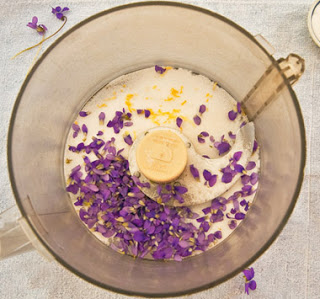
Be sure to use only unsprayed woodland violets like those pictured (or ones with a slightly different purple hue). African violets are not true violets and are not edible. It’s best to pick the violets early in the blooming period, as their color and aroma are most intense then. Plan to use them promptly, although they will keep placed in water and kept in a cool spot for up to 12 hours if necessary.
Sunlight causes the beautiful color to fade so be sure to keep violet sugar in a cool dark spot. The color does dull down after about a year–just in time to make a new batch when violets are in season again!
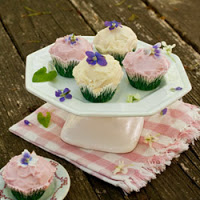
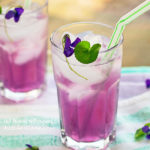 For violet pink lemonade go here.
For violet pink lemonade go here.
For my au natural raspberry and orange buttercream frostings decorated with violets go here.
For my candied violet recipe, go here. For more spring garden pictures featuring violets go here.

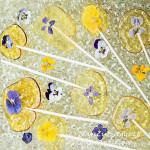

Francisca, you can keep some of the sugar granulated by not grinding the violets with all the sugar at the beginning. Reserve some of the sugar and just add it in at the end.
Hi, I made this sugar a while ago, actually before I found your blog nad it is indeed very pretty. The only problem for me is that I would like to keep the sugar a bit granulated but that is maybe not possible. I dried the violets a bit first and therefore I didn't have to dry the sugar in the oven. And, as at the same time I made some pink rose sugar as well I ended up having one cute little jar with violet sugar and the other one with pink sugar so I am going to offer both to my niece who had twins a little while ago, a boy and a girl. Thanks for the tips…..
Suzy,you turn the oven (not the broiler) on for 1 minute only, then turn it off again. This provides a slight amount of warmth which helps dry out the sugar so it won't clump during storage. However, if the oven temperature is any hotter, it causes the natural color to fade–botanical color pigments are rather fragile and fade from both too much heat, sunlight and exposure to air.
Hello! Thank you so much for posting this! I'm a bit confused though. When you say turn the oven on for one minute, do you mean turn the broiler on for one minute or just have it begin preheating for one minute?
Tinky, that is sooo lovely of you to say–really makes my day!
This is so GORGEOUS it almost makes me cry. Thanks as always for the wonderful idea, Nancy.
Yes, Dena, you can use any edible flower blooms the same way and create other naturally beautiful sugars. And herb leaves, like sage, tarragon, and mint can also be used. I actually think the softer, au naturel colors are prettier.
Oh, thank you so much! I just recently tried my first lavender shortbread cookie (eating it, not baking it!) and a blog reader suggested I try making my own culinary lavender. With your photographs, I now can't wait to try so many more kinds of edible sugars made with flowers and herbs right out of my garden.
It also helps that purple is my favorite color. Thank you, Nancy!
Melanie, thanks for commenting. Yes, the process intrigues me, too. So far, the natural violet color is lasting very well. You should still be able to find some violets–ours are just beginning to wane right now.
Katie, I think you'll be pleased if you try it. I love the fact that I don't have to use synthetic dyes and still get gorgeous color.
So Pretty! I must try this…XoXo
I really enjoyed this post Nancy. It is a fascinating process, which, is actually easier than I would have guessed. Now… I hope I can find some wild violets!
Such a great idea, gotta try this!